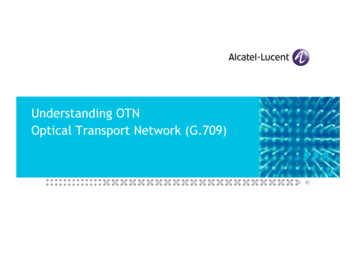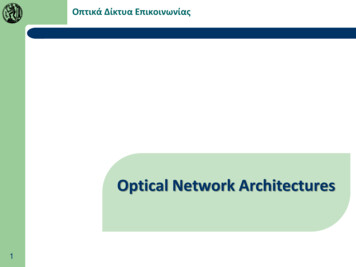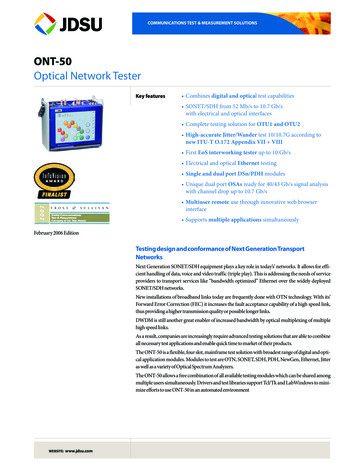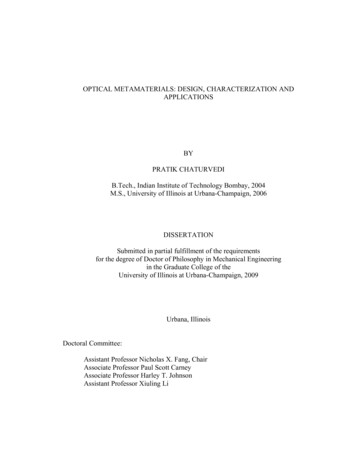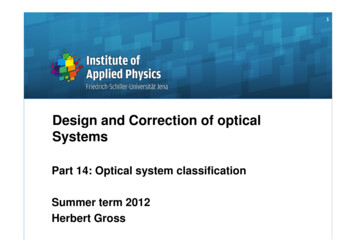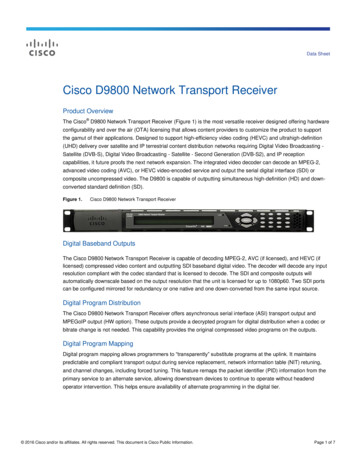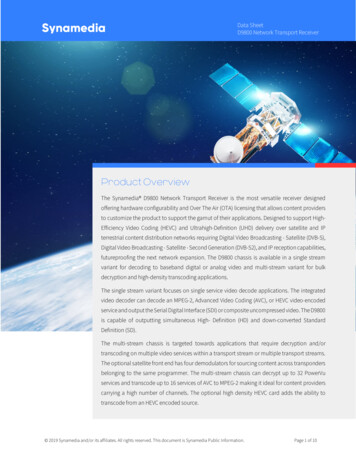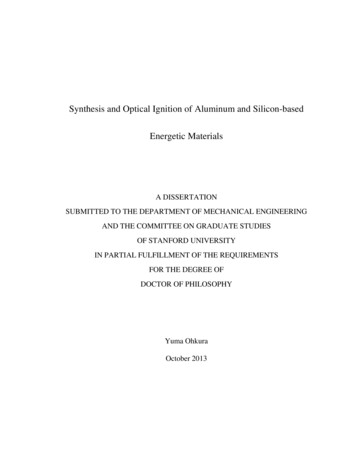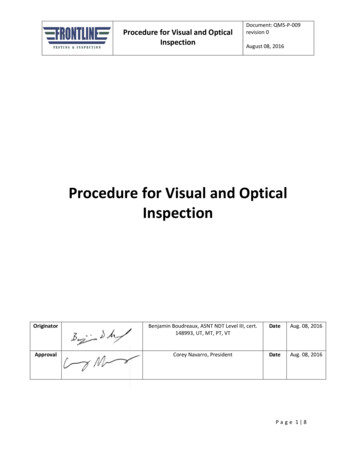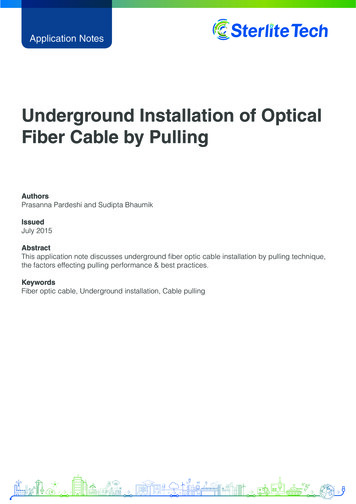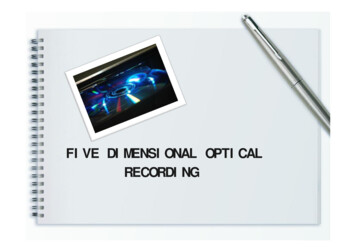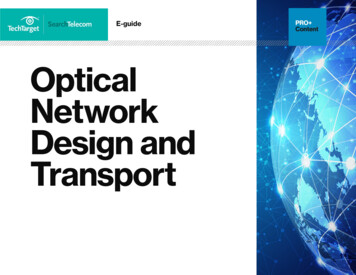
Transcription
E-guideOpticalNetworkDesign andTransport
E-guideBest practices for optical network designIn this e-guideBest practices for opticalnetwork designp.1100G DWDM opticalnetworking transportp.16A short history of 100GDWDM optical networktransport developmentp.23Enabling technologies for100G DWDM networktransmissionp.28Getting more PRO essentialcontentFiber-optic technology -- not long ago used only in long-haulnetworks -- has become the transmission medium of choice notonly in the core, but in metro and access networks. The gamechanger is global growth in consumer broadband and the need todistribute enormous amounts of content without hauling ithalfway around the world. This Telecom Insights guide to bestpractices for optical network design looks at access, metro andcore network issues affecting fiber deployment.Fiber-optic technology -- not long ago used only in long-haul networks -- hasbecome the transmission medium of choice not only in the core, but in metroand access networks. The game-changer is global growth in consumerbroadband and the need to distribute enormous amounts of content withouthauling it halfway around the world.This Telecom Insights guide to best practices for optical network designlooks at access, metro and core network issues affecting fiber deploymentincluding:Page 1 of 32
E-guideIn this e-guideBest practices for opticalnetwork designp.16DWDM optical networkp.23Enabling technologies for100G DWDM networktransmissionp.28Getting more PRO essentialcontentPage 2 of 32 Factors affecting metro network use of SONET, WDM or Ethernet,and the services that will be supported by fiber deployment Specific core optical network design considerations includingaggregation, geography and reconfigurability.Fiber-optic networks: Access network designA short history of 100Gtransport developmentRecent developments in FTTX ("fiber to the whatever") deploymentand passive optical networking (PON) technology in access networksp.1100G DWDM opticalnetworking transport The rapid growth in consumer broadband seen worldwide today would notbe possible without a major shift in the practices for provisioning accessinfrastructure. Copper loop and CATV cable were once the only means oftransporting information from a provider central office or head end to thecustomer. Today, both these media are being "shortened" or even eliminatedby the use of fiber optics.Fiber is not a new development in access networks. Not only has it beenused for almost two decades in the provisioning of high-speedcommercial/enterprise customers, service providers in the 1990s found thatreplacing large bundles of copper by a few fiber strands could improveservice reliability and lower craft cost. BellSouth took the lead in deployment
E-guideof access fiber in that period, and the move was justified completely on costsavings.In this e-guideBest practices for opticalnetwork designp.1100G DWDM opticalnetworking transportp.16A short history of 100GDWDM optical networktransport developmentp.23Enabling technologies for100G DWDM networktransmissionp.28Getting more PRO essentialcontentThe traditional access fiber architecture has been the fiber remote, which isa high-speed fiber trunk (SONET or Ethernet) that terminates in an electrooptical multiplexer. In analog phone days, these were called "digital loopcarriers" (DLCs), and the term "new generation DLC" was used for a time,but most such devices today deliver DSL services and so are usually called"remote DSLAMs." A remote DSLAM's primary benefit is to shorten theaccess copper to allow higher DSL speeds and improve reliability. Mostproviders would counsel against offering premium DSL on loops over 8,000feet, and the highest DSL speeds may be achievable only on loops 1,000feet or less in length.Pushing fiber close to the customer is generically called "deep fiber," andvarious acronyms are used to indicate just how deep the fiber is. FTTHmeans "fiber to the home," which is the extreme of giving every user anoptical-electrical termination. FTTC takes "fiber to the curb," serving a groupof homes, while FTTN means "fiber to the node" or "neighborhood," andallows each fiber remote to serve a larger population.The problem with all deep fiber strategies, and the reason why providersdon't simply run fiber to every home, is cost. If loops are kept to a length of5,000 feet, a single remote can serve customers in an area of almost 2,000acres. Shorten the loop to 1,000 feet and it serves only a little over 70 acres.Page 3 of 32
E-guideIn this e-guideBest practices for opticalnetwork designp.1100G DWDM opticalnetworking transportp.16A short history of 100GDWDM optical networktransport developmentp.23Enabling technologies for100G DWDM networktransmissionp.28Getting more PRO essentialcontentPage 4 of 32Since the user population is generally proportional to the geography, thisreduction means the cost per user could rise 50 times or more. Shorterloops mean higher speeds, however, and for video over IP, most operatorswould require at least 24 Mbps (ADSL2) connections. In Asia and someother areas, VDSL is used with speeds of 50 Mbps or more. Both theserequire much shorter loops (8,000 feet is optimum for ADSL2, according toreports, and 500-800 feet for 50 Mbps VDSL).Balancing cost and performance is the goal of the various passive opticalnetworking (PON) systems. PON creates a "tree" structure of fiberconnections using optical splices without electrical termination or handling.PON typically supports 32 branches, and each of these can in theory be aremote or a home. A single PON tree supporting 32 branches has 33electrical devices, counting the head end. Serving 32 locations with point-topoint fiber would require 64 electrical devices and generate higher costsand greater reliability risk.PON systems use a common fiber architecture but a variety of opto-electricapproaches. The original broadband PON (BPON) and the successor GigabitPON (GPON) are both based on ATM. The new Ethernet PON (EPON)standard has been ratified, and most operators contemplating major newPON deployments are conducting assessments and procurements of EPON.GPON and EPON have sufficient capacity for video delivery and high-speedInternet. Some providers like the ATM framework of GPON for its ability to
E-guidecreate multiple independent service channels to the user via virtual circuits.Others prefer EPON because it matches better with Ethernet-based metroarchitectures.In this e-guideBest practices for opticalnetwork designp.1100G DWDM opticalnetworking transportp.16A short history of 100GDWDM optical networktransport developmentp.23Enabling technologies for100G DWDM networktransmissionp.28Getting more PRO essentialcontentPlanning for access network fiber deployment demands a carefulconsideration of the following:1. The demographics of the area to be served, including householdincome, family size, and age distribution. This data is critical inestablishing the service market opportunity. In general, favorabledemographics justify deeper fiber deployment.2. The geography and topology of the service area, including thehousehold density (average lot size), the rights of way available, andwhether cabling is underground or above ground. This data is criticalto set the cost points for each approach. Obviously, poorcharacteristics here will create profit margin challenges if not takeninto account. Studies in Japan, where fiber deployment is high,indicate that even whether the ground is flat or hilly has an impact ondeployment cost.3. The service mix to be provided, over at least a five-year period,considering both trends in demand and in competition. The worstpossible outcome in an access fiber deployment is a new set ofPage 5 of 32
E-guiderequirements that the fiber architecture deployed cannot effectivelysupport.In this e-guideBest practices for opticalnetwork designp.1100G DWDM opticalnetworking transportp.16A short history of 100GDWDM optical networktransport developmentp.23Enabling technologies for100G DWDM networktransmissionp.28Getting more PRO essentialcontentPage 6 of 32In the installation and maintenance phase, access networks present specialproblems because of the high cost of rolling a truck to fix a problem. Abroadband consumer may require three years to pay back the cost of asingle service call. This means that it is absolutely critical that each fiberstrand be properly installed and that, in particular, the splicing used in PONinstallations be carefully done and verified. Fiber should also be tested endto-end prior to committing it to customers. Unlike copper, whose problemstend to develop over time, operators report that most fiber problems areuncovered shortly after installation and result from improper practices.Optical networks: Metro network design bestpracticesThe trends in telecommunications today show clearly that the largestincremental amount of fiber deployed in the next decade will not be in thenetwork core but in the access network and metro network. Content, thefuel of consumer broadband traffic growth, is an application that delivers arelatively small number of movies or programs to a large population of users.In most cases, this means that content will be cached at a metro level andthat the greatest traffic growth created by content will be in the metro area.
E-guideIn this e-guideBest practices for opticalnetwork designp.1100G DWDM opticalnetworking transportp.16A short history of 100GDWDM optical networktransport developmentp.23Enabling technologies for100G DWDM networktransmissionPage 7 of 32The advent of wavelength division multiplexing (WDM) -- coarse or dense -deployed in the 1550nm range has added versatility to metro optics byproviding multiple lightpaths per fiber and greatly increasing the capacity ofa given fiber strand. At the same time, the increased volume of packettraffic, which does not require SONET's synchronous delivery behavior, haschanged the traffic profile for the metro network of the future. Today,Ethernet is more likely to be the planned electrical layer of metro networks,and WDM the optical. This shift is changing the balance of tasks betweenelectrical and optical components and the best practices for deployment.p.28Getting more PRO essentialcontentMetro fiber today is based largely on SONET, which is 1310nm singlewavelength deployment. SONET networks are usually constructed as aseries of protected rings that allow fast failover to the alternate "rotation" inthe event of a fiber cut. Rings are connected via optical add/dropmultiplexers (ADMs).SONET rings can be replicated in metro Ethernet and dense wavelengthdivision multiplexing (DWDM) networks by simply using the same fiber andrelying on wavelength separation or by running multiple SONET paths overWDM. Since there are probably no major metro networks worldwide withoutany traditional synchronous TDM traffic, planners should expect to use ahybrid of SONET and Ethernet technology. Where there is a large installedbase of SONET equipment, no plans to eliminate PSTN switches, and majorcustomers with direct SONET access, it may be advisable to plan a
E-guidetransition in the metro optical network from SONET-over-1310 toSONET/WDM and then to begin to integrate Ethernet-over-SONET, finallymoving portions of the network to Ethernet-over-WDM.In this e-guideBest practices for opticalnetwork designp.1100G DWDM opticalnetworking transportp.16A short history of 100GDWDM optical networktransport developmentp.23Enabling technologies for100G DWDM networktransmissionp.28Getting more PRO essentialcontentPage 8 of 32The changing economics of WDM appear to be defusing the "SONETreplacement" issue. Most operators now expect to maintain SONET forPSTN transport for as long as those services are offered, moving to nonSONET architectures only as packet voice displaces TDM voice. However,the gradual evolution is most likely to be compromised by explodingconsumer broadband use, particularly by IPTV plans. Operators report voicetraffic is stable while data traffic is growing at often triple-digit rates. Thefaster packet traffic grows relative to "circuit" or TDM traffic, the more likelyit is that hybrids of SONET and Ethernet (Ethernet over SONET) will havetoo small a window of value to justify investment. This is probably the reasonwhy more and more optical vendors are offering hybrid products withreconfigurable add-drop multiplexing (ROADM) and Ethernet.A WDM issue that receives considerable media play is the way in whichtransit optical connections are handled. Most products have convertedbetween optical and electrical (O-E-O) to perform a wavelength transitconnection because pure optical cross-connect (O-O-O) has beenexpensive. While O-O-O products have been available for five years or so,most vendors still use O-E-O technology.
E-guideIn this e-guideBest practices for opticalnetwork designp.1100G DWDM opticalnetworking transportp.16A short history of 100GDWDM optical networktransport developmentp.23Enabling technologies for100G DWDM networktransmissionp.28Getting more PRO essentialcontentPage 9 of 32The primary issue today is still cost; service providers believe that futureROADM products will provide all-optical transit connections. The key issuefor designers, regardless of the mechanism used, is that wavelengths can be"transcoded" to a different wavelength across the switch; a system that failsto provide this is too complex to manage because wavelength assignmenton various fibers becomes interdependent, and some reconfiguration modesmay not be available because of collisions.Metro optical deployment is affected by the service mix to be supported, butthe service topology has an equal or greater impact. A primary question tobe addressed is the amount of intra-metro traffic to be carried relative to thevolume of traffic that will simply be connected to a metroPOP for transportoutside the metro area.In areas where consumer broadband traffic makes up the bulk of totaltraffic, most fiber deployment will focus on linking serving offices to a POPfor core network interconnect. While these connections have to provideresiliency, they will rarely require the SONET standard of failover, 50ms,since they will support Ethernet traffic. The introduction of IPTV may changethis picture because loss of connectivity will cause pixelization that mayproduce viewer dissatisfaction, particularly on pay-per-view systems. If userbuffering is available, the failover time should be no more than about twothirds of the buffer interval. Often, consumer broadband failover is bestaccomplished at the Ethernet level.
E-guideIn this e-guideBest practices for opticalnetwork designp.1Where there is significant synchronous (TDM) traffic and significantcorporate packet traffic, it may be necessary to provide optical failover atSONET 50ms levels, in which case SONET or resilient packet ring (RPR)may be required. As noted, WDM may allow metro optical designers toseparate traffic according to optical failover requirements and provideimproved failover only where needed.100G DWDM opticalnetworking transportp.16A short history of 100GDWDM optical networktransport developmentp.23Enabling technologies for100G DWDM networktransmissionp.28Getting more PRO essentialcontentReconfigurability, meaning the ability to create variable metro opticaltopologies by interconnecting wavelengths in various ways, is most likely tobe needed either to accommodate a large amount of business traffic (metroEthernet services) or to support alternate routing between serving officesand metroPOPs where the core network connection is made. Where IPTV isdelivered, this multi-homing may also be needed for content service points.At the optical layer, reconfigurability and fast failover are very differentthings. ROADMs offer a great amount of topology flexibility to adapt tochanges in traffic demands, to the point where wavelength services can beoffered to metro customers and where even Gigabit Ethernet customerscan be quickly accommodated. Adding rapid and multiple spanning trees toEthernet can provide resiliency at the electrical layer for everything but themost stringent failover requirements.Many believe that metro optics will, over time, migrate away from the 50msfailover standard of SONET as circuit-switched and TDM traffic become asmaller portion of network load. If this is true, then a pure ROADM-and-Page 10 of 32
E-guideEthernet solution, particularly one based on one-box optical/electricalapproaches, may be the best long-term solution.In this e-guideBest practices for opticalnetwork designp.1100G DWDM opticalnetworking transportp.16A short history of 100GDWDM optical networktransport developmentp.23Enabling technologies for100G DWDM networktransmissionp.28Getting more PRO essentialcontentPage 11 of 32Optical networks: Core network design bestpracticesOptical networking is the only relevant Layer 1 technology today in thenetwork's core except in very unusual markets or geographic conditionswhere terrestrial microwave may still be deployed. While core opticalnetwork deployments in some areas may be literally indistinguishable frommetro fiber, there are other networks where the key requirements are totallydifferent. Thus, the first question in optical network design and deploymentfor core networks is the nature of the network itself, and how core andmetro requirements might differ.The "core" of a network is a place where aggregated traffic moves amongon- and off-ramps. Because the traffic is highly aggregated and thusrepresents thousands or millions of user relationships, core network nodesare likely to have traffic destined for virtually all other core nodes, meaningthat the nodes are highly interconnected. This may contrast sharply withmetro networks, where "preferred topologies" often involve simplyconnecting serving or edge offices with points of presence (POPs) forconnection to the core -- a star topology instead of a mesh.
E-guideIn this e-guideBest practices for opticalnetwork designp.1100G DWDM opticalnetworking transportp.16A short history of 100GDWDM optical networktransport developmentp.23Enabling technologies for100G DWDM networktransmissionp.28Getting more PRO essentialcontentPage 12 of 32The aggregation of traffic onto the core creates another difference in coreoptical networks: It is unlikely that a single network user will contribute alarge portion of total traffic, and thus adding new users will generally notchange the core significantly. In contrast, a large metro user may requirereconfiguration of network bandwidth to accommodate the traffic. For thisreason, and because of the "mesh" factor above, reconfigurability is likely tobe less of an issue in core networks.Core networks are also typically immune from the need for fast failover, the50 ms optical alternate routing available with SONET. Ring configurationsusing fully redundant fiber paths are harder to create and more expensive tomaintain in core networks, and so resilience is typically left to the electricallayer.The final difference is that of geographic scope. A large metro networkmight span 50 to 100 km; a large core optical network can circle the globe.This long reach necessarily means that core fiber may have to span greatdistances without intermediate repeaters, including submarineenvironments, deserts, etc. Thus, ultra-long-haul fiber technology is oftencritical in core networks. The greater geographic scope of the core networkalso means getting craft personnel to an area to fix a problem may requiredays or weeks, and so it is critical to have some form of backup plan and toreduce outages as much as possible through design.
E-guideIn this e-guideBest practices for opticalnetwork designp.1100G DWDM opticalnetworking transportp.16A short history of 100GDWDM optical networktransport developmentp.23Enabling technologies for100G DWDM networktransmissionp.28Getting more PRO essentialcontentPage 13 of 32One issue that
Ethernet is more likely to be the planned electrical layer of metro networks, and WDM the optical. This shift is changing the balance of tasks between electrical and optical components and the best practices for deployment. SONET rings can be replicate
